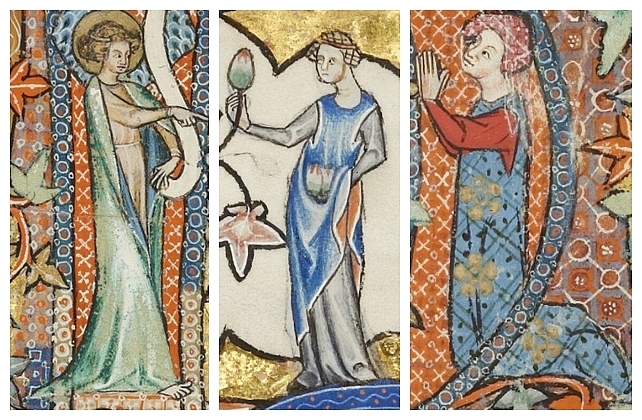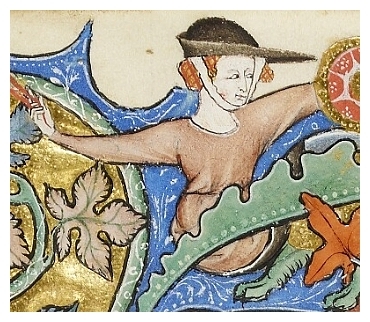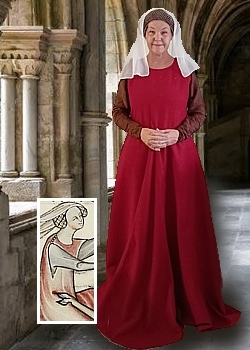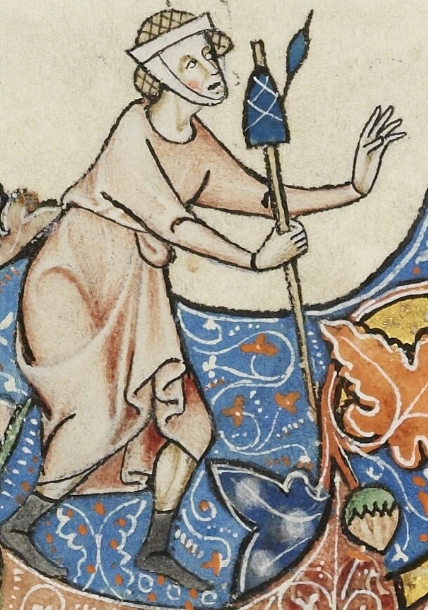Ormesby Psalter Style Guide.
6 February 2024 10:40 amI have found my style guide!
For quite a long time I've wanted to narrow down my 14th century impression. In fact, I've thought it might be fun to narrow it down to a style guide from a single manuscript, rather than a broad spectrum of many in the same time period. My thought was it might be fun to do not just one time period and geographical region, but one manuscript. Initially, my re-enactment start was peppered with "14th century, England" while I cherry picked the best bits I liked and threw them enthusiastically together. I tried to consider what went with what and whether I should use something, not just if I could.
I discovered the Luttrell Psalter, as everyone does. It has a lot of daily life and is pretty great and for a while I loved it so much.
The lure of the slightly later 14th century- past the fashion change of the gownes and tunics and into the form-fitting kirtles and mega buttons and frilly veils called and I discovered the Bohun Psalter, which I had thought to use as my style guide. It has many pictures of items from kitchen ware to small chests and a large variety of clothing. I started a Project.
And that was it's downfall for me. I really could just go back to justifying almost everything, (which is okay)... but there were a LOT of frilly veils and absolutely no barbettes. I really love barbettes.
I've made a few false starts here, but I think I have found one which ticks a large number of boxes for me. The Ormesby Psalter. MS Douce 366, Bodleian Library. It has a lot of cool stuff I really like. The tri-spotty cintamani fabric. Many squirrels. Heraldic clothing. And some household things, although nowhere near as much as the Bohun or Luttrell Psalters.
Highlights include:

Gownes, surcotes with high armholes, a heraldic sort of surcote (the heraldry has the gold flowers but a plain blue background whereas this has a diapered patterned fabric in the blue) translucent veils, hairnets, circlets and a weird hairnet which looks more like a shower cap than anything else.

Headwear wise, circlets and flower crowns, hairnets with decorative embroidery (those are the dots, which we can see are embroidered on extant ones), several styles of barbette and fillets including a slightly pleaty one.
There are some nice decorative motifs going on which are repeated.

Squirrels. Lots of squirrels in dividers, in margins and as a Lady's pet. The shoulder buttons on the surcote are pretty cool too and do make the surcote easier to get off and on. Table cloths with red stripes and fringing instead of the traditional blue. Cornflowers. There are cornflowers used decoratively, and I really love cornflowers. I would like to use them in camp as a flower alternative to roses (though always roses are a winner!) Not shown here is a painted mirror which is red with a gold border and an ivory comb; two items which tie into my health and hygiene display too.
The time period and country fits with my main interest, historically and although there are gaps in the manuscript for documenting some items, many are generic across others in the same place and time, and other gaps can be filled from artifacts from the Museum of London and my personal collection.
 One of the coolest things, style wise, is a lady wearing a peaked cap combined with a red hairnet and barbette.
One of the coolest things, style wise, is a lady wearing a peaked cap combined with a red hairnet and barbette.
This is the only one I've seen.
There are very, very, very few images of women wearing this style of hat although an enormous number of re-enactor ladies wear them. Indeed, one could expect to see them in every painting and manuscript based on the number of people who wear them, when in fact, they are extremely rare.
I was astonished to find such a rare image in the Ormesby Psalter, but thought it was rather cool that of all manuscripts I've pored over, this actual one not only contained such a rare picture, but it was in the manuscript I was considering for my personal style guide.
This has been great news for me, because years ago I bought a peaked cap to wear (like everyone else) assuming that because it was widely worn, there was ample documentation for it across many areas, countries, and almost over the entire 14th and 15th centuries, and when the time came to gather documentation, I was extremely sad to learn that it was so extremely rare and the best known image was Italian and not even my country of choice, that I made the sad decision to not wear it as it wasn't an accurate representation of something I would be wearing as an Englishwoman at that particular time. I noticed there was no veil worn with this and will need to adopt that too. No hat jewel. No pilgrim badges. No feathers. Just the peaked cap.
The Ormesby Psalter ticks a great deal of my boxes. I've already snipped all of the images and broken them down into clothes, headwear, veils, animals, decorative features and it won't be too long before I have it all catalogued and grouped into items for a really good comparative of things I can use to put together an impression based on a single manuscript.
I am certainly going to try and see how I go!
For quite a long time I've wanted to narrow down my 14th century impression. In fact, I've thought it might be fun to narrow it down to a style guide from a single manuscript, rather than a broad spectrum of many in the same time period. My thought was it might be fun to do not just one time period and geographical region, but one manuscript. Initially, my re-enactment start was peppered with "14th century, England" while I cherry picked the best bits I liked and threw them enthusiastically together. I tried to consider what went with what and whether I should use something, not just if I could.
I discovered the Luttrell Psalter, as everyone does. It has a lot of daily life and is pretty great and for a while I loved it so much.
The lure of the slightly later 14th century- past the fashion change of the gownes and tunics and into the form-fitting kirtles and mega buttons and frilly veils called and I discovered the Bohun Psalter, which I had thought to use as my style guide. It has many pictures of items from kitchen ware to small chests and a large variety of clothing. I started a Project.
And that was it's downfall for me. I really could just go back to justifying almost everything, (which is okay)... but there were a LOT of frilly veils and absolutely no barbettes. I really love barbettes.
I've made a few false starts here, but I think I have found one which ticks a large number of boxes for me. The Ormesby Psalter. MS Douce 366, Bodleian Library. It has a lot of cool stuff I really like. The tri-spotty cintamani fabric. Many squirrels. Heraldic clothing. And some household things, although nowhere near as much as the Bohun or Luttrell Psalters.
Highlights include:

Gownes, surcotes with high armholes, a heraldic sort of surcote (the heraldry has the gold flowers but a plain blue background whereas this has a diapered patterned fabric in the blue) translucent veils, hairnets, circlets and a weird hairnet which looks more like a shower cap than anything else.

Headwear wise, circlets and flower crowns, hairnets with decorative embroidery (those are the dots, which we can see are embroidered on extant ones), several styles of barbette and fillets including a slightly pleaty one.
There are some nice decorative motifs going on which are repeated.

Squirrels. Lots of squirrels in dividers, in margins and as a Lady's pet. The shoulder buttons on the surcote are pretty cool too and do make the surcote easier to get off and on. Table cloths with red stripes and fringing instead of the traditional blue. Cornflowers. There are cornflowers used decoratively, and I really love cornflowers. I would like to use them in camp as a flower alternative to roses (though always roses are a winner!) Not shown here is a painted mirror which is red with a gold border and an ivory comb; two items which tie into my health and hygiene display too.
The time period and country fits with my main interest, historically and although there are gaps in the manuscript for documenting some items, many are generic across others in the same place and time, and other gaps can be filled from artifacts from the Museum of London and my personal collection.
 One of the coolest things, style wise, is a lady wearing a peaked cap combined with a red hairnet and barbette.
One of the coolest things, style wise, is a lady wearing a peaked cap combined with a red hairnet and barbette. This is the only one I've seen.
There are very, very, very few images of women wearing this style of hat although an enormous number of re-enactor ladies wear them. Indeed, one could expect to see them in every painting and manuscript based on the number of people who wear them, when in fact, they are extremely rare.
I was astonished to find such a rare image in the Ormesby Psalter, but thought it was rather cool that of all manuscripts I've pored over, this actual one not only contained such a rare picture, but it was in the manuscript I was considering for my personal style guide.
This has been great news for me, because years ago I bought a peaked cap to wear (like everyone else) assuming that because it was widely worn, there was ample documentation for it across many areas, countries, and almost over the entire 14th and 15th centuries, and when the time came to gather documentation, I was extremely sad to learn that it was so extremely rare and the best known image was Italian and not even my country of choice, that I made the sad decision to not wear it as it wasn't an accurate representation of something I would be wearing as an Englishwoman at that particular time. I noticed there was no veil worn with this and will need to adopt that too. No hat jewel. No pilgrim badges. No feathers. Just the peaked cap.
The Ormesby Psalter ticks a great deal of my boxes. I've already snipped all of the images and broken them down into clothes, headwear, veils, animals, decorative features and it won't be too long before I have it all catalogued and grouped into items for a really good comparative of things I can use to put together an impression based on a single manuscript.
I am certainly going to try and see how I go!



